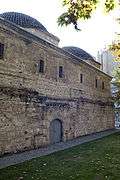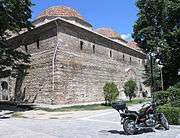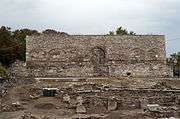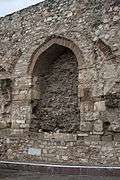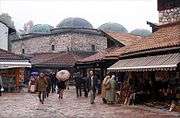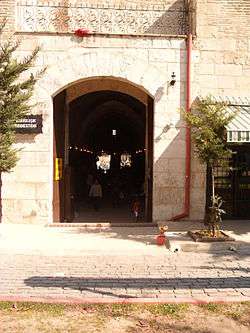Bedesten
A Bedestan (or bezistan or bedesten) is a covered market usually for haberdashery and craftsmanship.[1] Bezistans were built in Ottoman Empire and their design is based on the design of the mosques.[2]
A Bedestan, in the most basic definition, is the central building of the commercial part of the town. It has its origins in the Greco-Roman Basilica or Kaiserion, which served a similar purpose .
The Bedestan was such an important building that during Ottoman times cities were often classified under two categories, cities with a Bedestan and cities without a Bedestan.
[3]
Etymology
The origin of the word is Arab word bez, which means clothes, linen but also indicating embroidery and other precious items, and Persian suffix istan.[4]
Examples of Bedestens
Numerous bezistans were built during Ottoman Empire, but not all of them survived. Some of the most notable bezistans are:
- Gazi-Husrev Beg's Bezistan in Baščaršija, Sarajevo, Bosnia and Herzegovina.[5]
- Brusa Bezistan, also in Sarajevo.[6]
- Bezistan in Old Bazaar, Skopje, Macedonia
- Bezistan in Bitola, Macedonia[7]
- Bezistan in Serres, Greece - today it houses the Archaeological Museum of Serres.[8]
- Bezistan - castle in Larissa, Greece.
- Bedesten in Nicosia, Cyprus - originally a Greek Orthodox church from the 6th and 14th centuries, architecturally different from all other Ottoman bezistans[9]
- Bezistan in Thessaloniki, Greece.[10]
| Examples of Bedestens in the Balkans. |
|---|
| Bezistan in Serres, Greece - Archaeological Museum of Serres. |
|
| Examples of Bedestens in Turkey. |
|---|
|
References
- ↑ Khadra Jayyusi, Salma; Renata Holod; Attilio Petruccioli; André Raymond (2008). "The Ottoman cities on the Balkans". The city in the Islamic world. Leiden ; Boston: Brill. p. 149. ISBN 978-90-04-16240-2. Retrieved 3 November 2011.
...bedesten (or bezistan, meaning enclosed market)...
- ↑ Norris, H. T. (1993). "Glossary". Islam in the Balkans: religion and society between Europe and the Arab world. London: Hurst. p. xiv. ISBN 978-1-85065-167-3. Retrieved 3 November 2011.
- ↑ Kreiser, Klaus: „Bedesten-Bauten im Osmanischen Reich. Ein vorläufiger Überblick auf Grund der Schriftquellen.“, in: Istanbuler Mitteilungen (Deutsches Archäologisches Institut, Abteilung Istanbul) 2, pp.367-400 (Tübingen 1979), reprint in Istanbul und das Osmanische Reich. Derwischwesen, Baugeschichte, Inschriftenkunde. Istanbul: Isis 1995. 286 S. (Analecta Isisiana. 14) pp.61-96.
- ↑ Zeitschrift für Ethnologie. Springer-Verlag. 1974. p. 226. Retrieved 3 November 2011.
- 1 2 "Brusa bezistan (Rustem Pasha bezistan, Small bezistan) with shops, the architectural ensemble". Bosna i Hertegovina - Commission to Preserve National Monuments. Archived from the original on 2012-05-01. Retrieved 2011-11-05.
- ↑ "Gazi Husrev-beg bezistan with shops, the architectural ensemble". Bosna i Hertegovina - Commission to Preserve National Monuments. Archived from the original on 2012-05-01. Retrieved 2011-11-05.
- ↑ "Bitola bezistan (Covered bazaar)".
- ↑ Βασίλης Κωστοβασίλης. "Μπεζεστένι Σερρών". τμήμα του άρθρου "Τα Μπεζεστένια - Οι μεγάλες σκεπαστές αγορές", Ελληνικό Πανόραμα Αριθ. τεύχους 30 - 2002, σελ. 102-131. Ιστοσελίδα Κεντρικής Βιβλιοθήκης Σερρών. Retrieved 2011-11-05.
- ↑ Bağışkan, Tuncer (8 November 2014). "Kıbrıs'ta Osmanlı – Türk Eserleri (5)" (in Turkish). Yeni Düzen. Retrieved 24 July 2015.
- ↑ Αλίκη Σαμουηλίδου - Αιμιλία Στεφανίδου-Φωτιάδου (May 1983). "Η Θεσσαλονίκη κατά την Τουρκοκρατία - Τα τουρκικά μνημεία". Περιοδικό Αρχαιολογία. 7: 62. Archived from the original on 2012-04-02.
External links
